MB09 Industry Project 01: Unilever Problem Identification
VerifiedAdded on 2023/06/08
|11
|2576
|334
Report
AI Summary
This report provides a strategic analysis of Unilever, a British consumer goods company, focusing on problem identification within its HR department. The report begins with an introduction to problem identification in project management, followed by a strategic examination of Unilever using models like SWOT and Porter's Five Forces. It identifies key challenges such as conflicting situations, insufficient communication, employee cutbacks, and the emphasis on profit maximization affecting employee engagement. The analysis then justifies the project's focus by exploring potential solutions, including reward and recognition, and visionary leadership, drawing on various scholarly perspectives. The report concludes by summarizing the vital importance of understanding and addressing organizational problems. This document is a valuable resource for students studying leadership management and project management, available on Desklib along with other study materials.
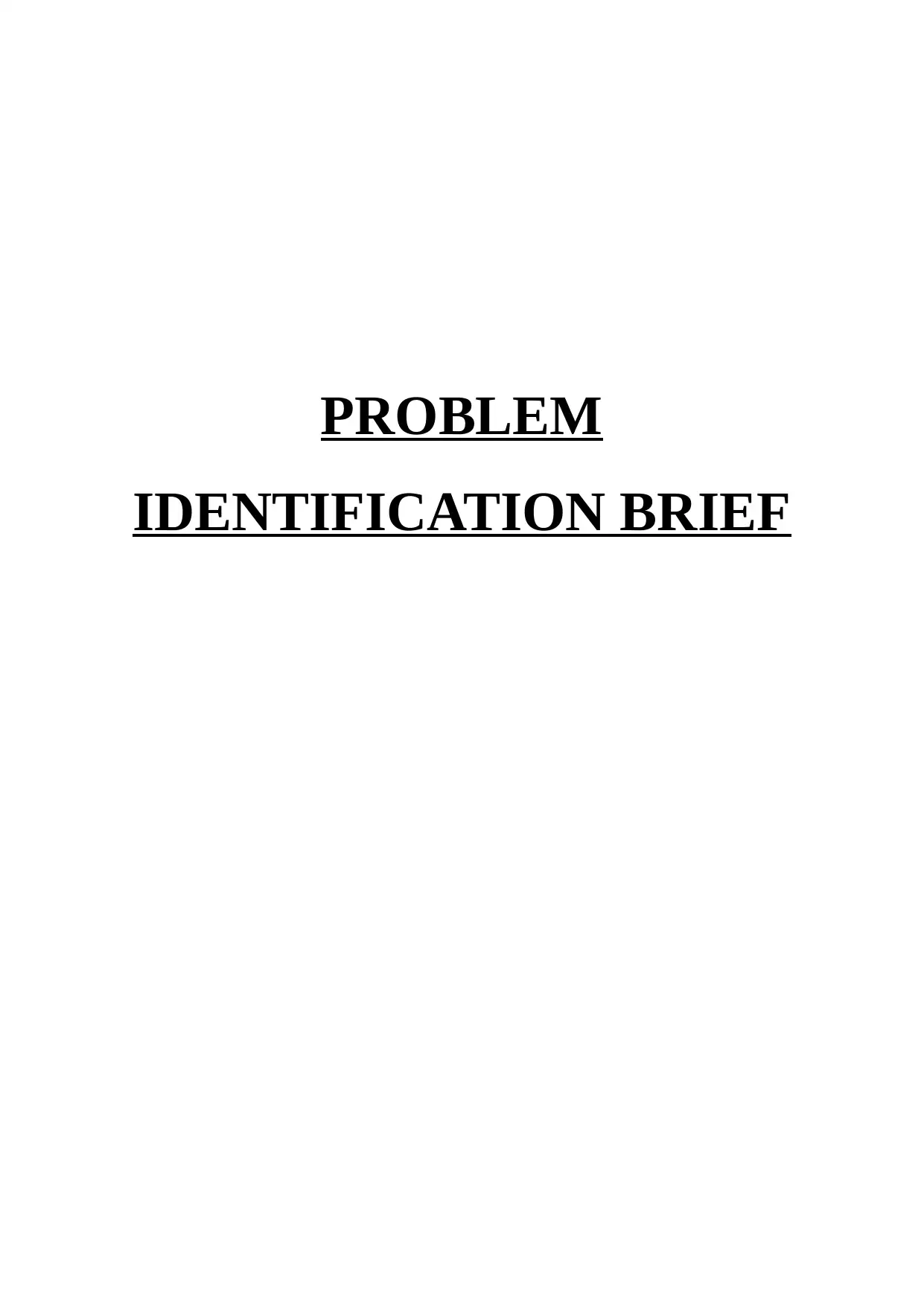
PROBLEM
IDENTIFICATION BRIEF
IDENTIFICATION BRIEF
Secure Best Marks with AI Grader
Need help grading? Try our AI Grader for instant feedback on your assignments.
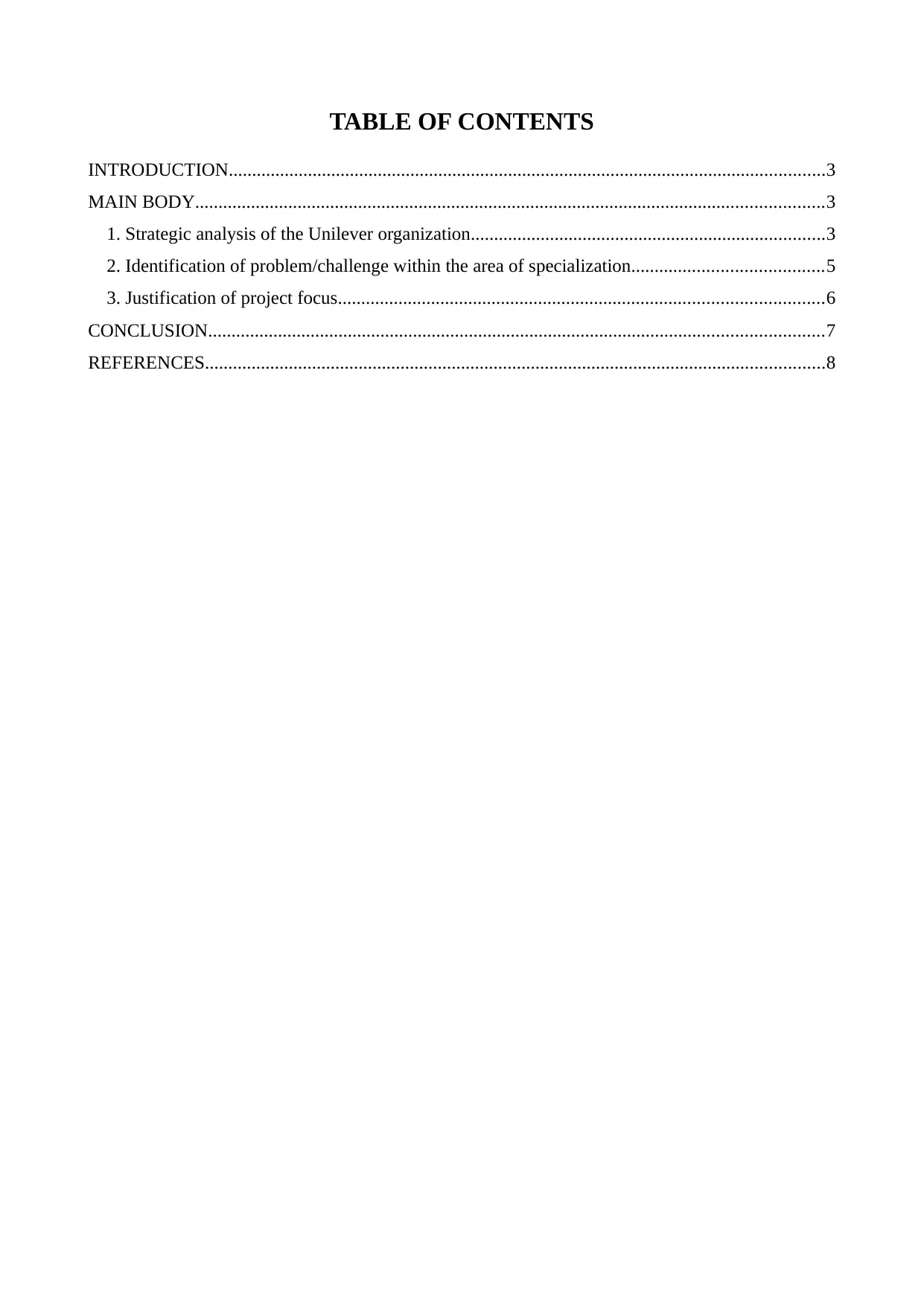
TABLE OF CONTENTS
INTRODUCTION................................................................................................................................3
MAIN BODY.......................................................................................................................................3
1. Strategic analysis of the Unilever organization............................................................................3
2. Identification of problem/challenge within the area of specialization.........................................5
3. Justification of project focus........................................................................................................6
CONCLUSION....................................................................................................................................7
REFERENCES.....................................................................................................................................8
INTRODUCTION................................................................................................................................3
MAIN BODY.......................................................................................................................................3
1. Strategic analysis of the Unilever organization............................................................................3
2. Identification of problem/challenge within the area of specialization.........................................5
3. Justification of project focus........................................................................................................6
CONCLUSION....................................................................................................................................7
REFERENCES.....................................................................................................................................8
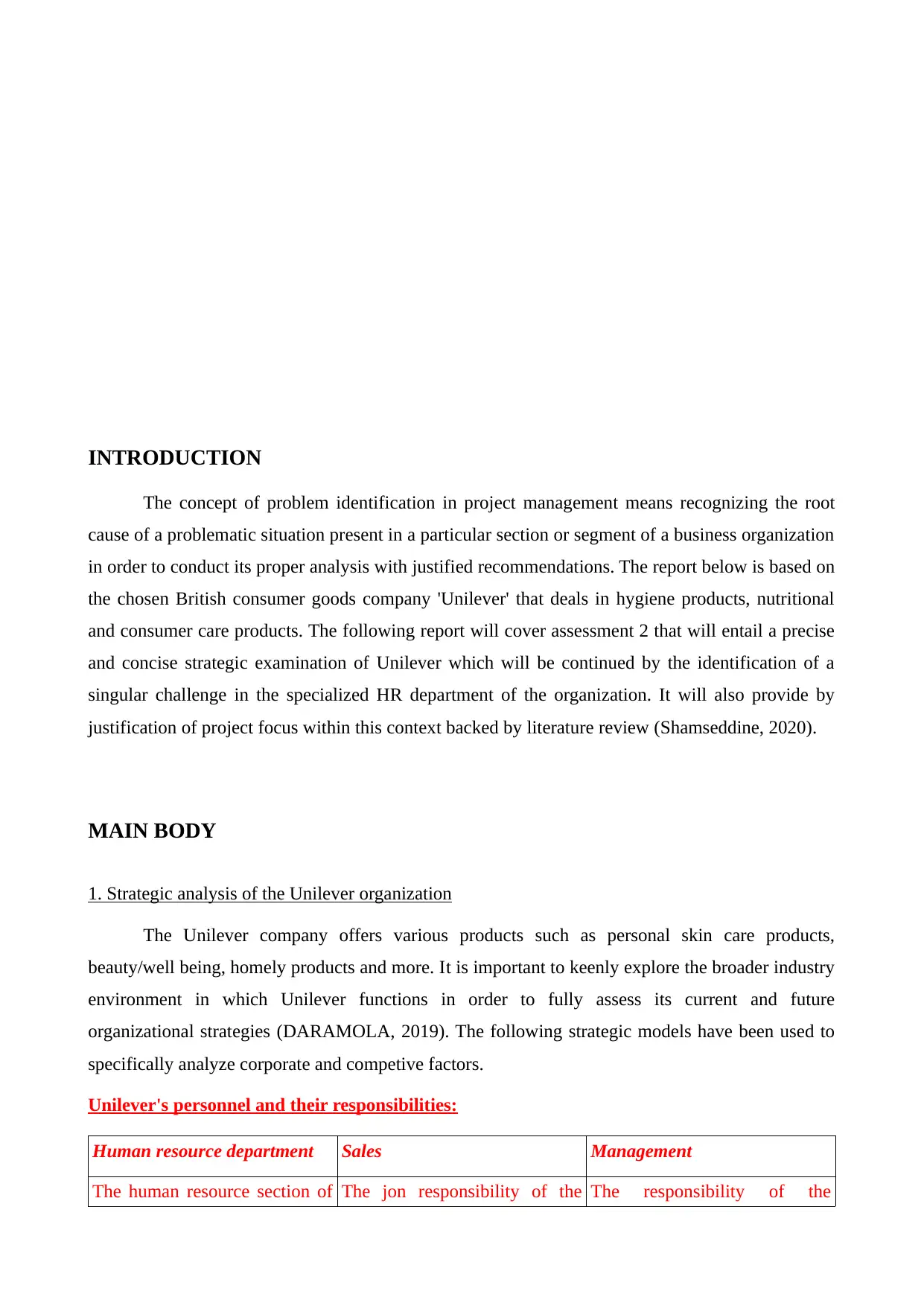
INTRODUCTION
The concept of problem identification in project management means recognizing the root
cause of a problematic situation present in a particular section or segment of a business organization
in order to conduct its proper analysis with justified recommendations. The report below is based on
the chosen British consumer goods company 'Unilever' that deals in hygiene products, nutritional
and consumer care products. The following report will cover assessment 2 that will entail a precise
and concise strategic examination of Unilever which will be continued by the identification of a
singular challenge in the specialized HR department of the organization. It will also provide by
justification of project focus within this context backed by literature review (Shamseddine, 2020).
MAIN BODY
1. Strategic analysis of the Unilever organization
The Unilever company offers various products such as personal skin care products,
beauty/well being, homely products and more. It is important to keenly explore the broader industry
environment in which Unilever functions in order to fully assess its current and future
organizational strategies (DARAMOLA, 2019). The following strategic models have been used to
specifically analyze corporate and competive factors.
Unilever's personnel and their responsibilities:
Human resource department Sales Management
The human resource section of The jon responsibility of the The responsibility of the
The concept of problem identification in project management means recognizing the root
cause of a problematic situation present in a particular section or segment of a business organization
in order to conduct its proper analysis with justified recommendations. The report below is based on
the chosen British consumer goods company 'Unilever' that deals in hygiene products, nutritional
and consumer care products. The following report will cover assessment 2 that will entail a precise
and concise strategic examination of Unilever which will be continued by the identification of a
singular challenge in the specialized HR department of the organization. It will also provide by
justification of project focus within this context backed by literature review (Shamseddine, 2020).
MAIN BODY
1. Strategic analysis of the Unilever organization
The Unilever company offers various products such as personal skin care products,
beauty/well being, homely products and more. It is important to keenly explore the broader industry
environment in which Unilever functions in order to fully assess its current and future
organizational strategies (DARAMOLA, 2019). The following strategic models have been used to
specifically analyze corporate and competive factors.
Unilever's personnel and their responsibilities:
Human resource department Sales Management
The human resource section of The jon responsibility of the The responsibility of the
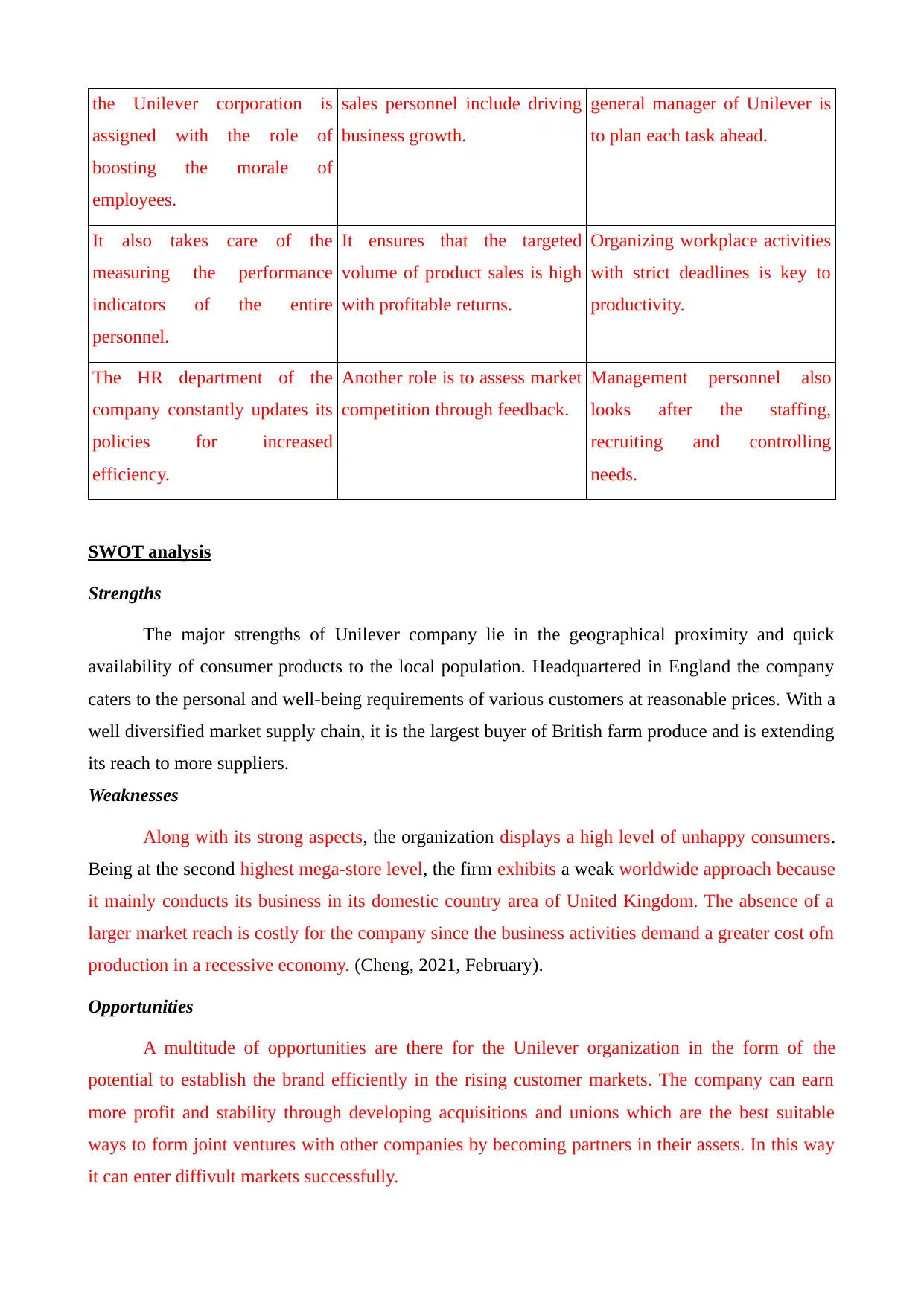
the Unilever corporation is
assigned with the role of
boosting the morale of
employees.
sales personnel include driving
business growth.
general manager of Unilever is
to plan each task ahead.
It also takes care of the
measuring the performance
indicators of the entire
personnel.
It ensures that the targeted
volume of product sales is high
with profitable returns.
Organizing workplace activities
with strict deadlines is key to
productivity.
The HR department of the
company constantly updates its
policies for increased
efficiency.
Another role is to assess market
competition through feedback.
Management personnel also
looks after the staffing,
recruiting and controlling
needs.
SWOT analysis
Strengths
The major strengths of Unilever company lie in the geographical proximity and quick
availability of consumer products to the local population. Headquartered in England the company
caters to the personal and well-being requirements of various customers at reasonable prices. With a
well diversified market supply chain, it is the largest buyer of British farm produce and is extending
its reach to more suppliers.
Weaknesses
Along with its strong aspects, the organization displays a high level of unhappy consumers.
Being at the second highest mega-store level, the firm exhibits a weak worldwide approach because
it mainly conducts its business in its domestic country area of United Kingdom. The absence of a
larger market reach is costly for the company since the business activities demand a greater cost ofn
production in a recessive economy. (Cheng, 2021, February).
Opportunities
A multitude of opportunities are there for the Unilever organization in the form of the
potential to establish the brand efficiently in the rising customer markets. The company can earn
more profit and stability through developing acquisitions and unions which are the best suitable
ways to form joint ventures with other companies by becoming partners in their assets. In this way
it can enter diffivult markets successfully.
assigned with the role of
boosting the morale of
employees.
sales personnel include driving
business growth.
general manager of Unilever is
to plan each task ahead.
It also takes care of the
measuring the performance
indicators of the entire
personnel.
It ensures that the targeted
volume of product sales is high
with profitable returns.
Organizing workplace activities
with strict deadlines is key to
productivity.
The HR department of the
company constantly updates its
policies for increased
efficiency.
Another role is to assess market
competition through feedback.
Management personnel also
looks after the staffing,
recruiting and controlling
needs.
SWOT analysis
Strengths
The major strengths of Unilever company lie in the geographical proximity and quick
availability of consumer products to the local population. Headquartered in England the company
caters to the personal and well-being requirements of various customers at reasonable prices. With a
well diversified market supply chain, it is the largest buyer of British farm produce and is extending
its reach to more suppliers.
Weaknesses
Along with its strong aspects, the organization displays a high level of unhappy consumers.
Being at the second highest mega-store level, the firm exhibits a weak worldwide approach because
it mainly conducts its business in its domestic country area of United Kingdom. The absence of a
larger market reach is costly for the company since the business activities demand a greater cost ofn
production in a recessive economy. (Cheng, 2021, February).
Opportunities
A multitude of opportunities are there for the Unilever organization in the form of the
potential to establish the brand efficiently in the rising customer markets. The company can earn
more profit and stability through developing acquisitions and unions which are the best suitable
ways to form joint ventures with other companies by becoming partners in their assets. In this way
it can enter diffivult markets successfully.
Secure Best Marks with AI Grader
Need help grading? Try our AI Grader for instant feedback on your assignments.
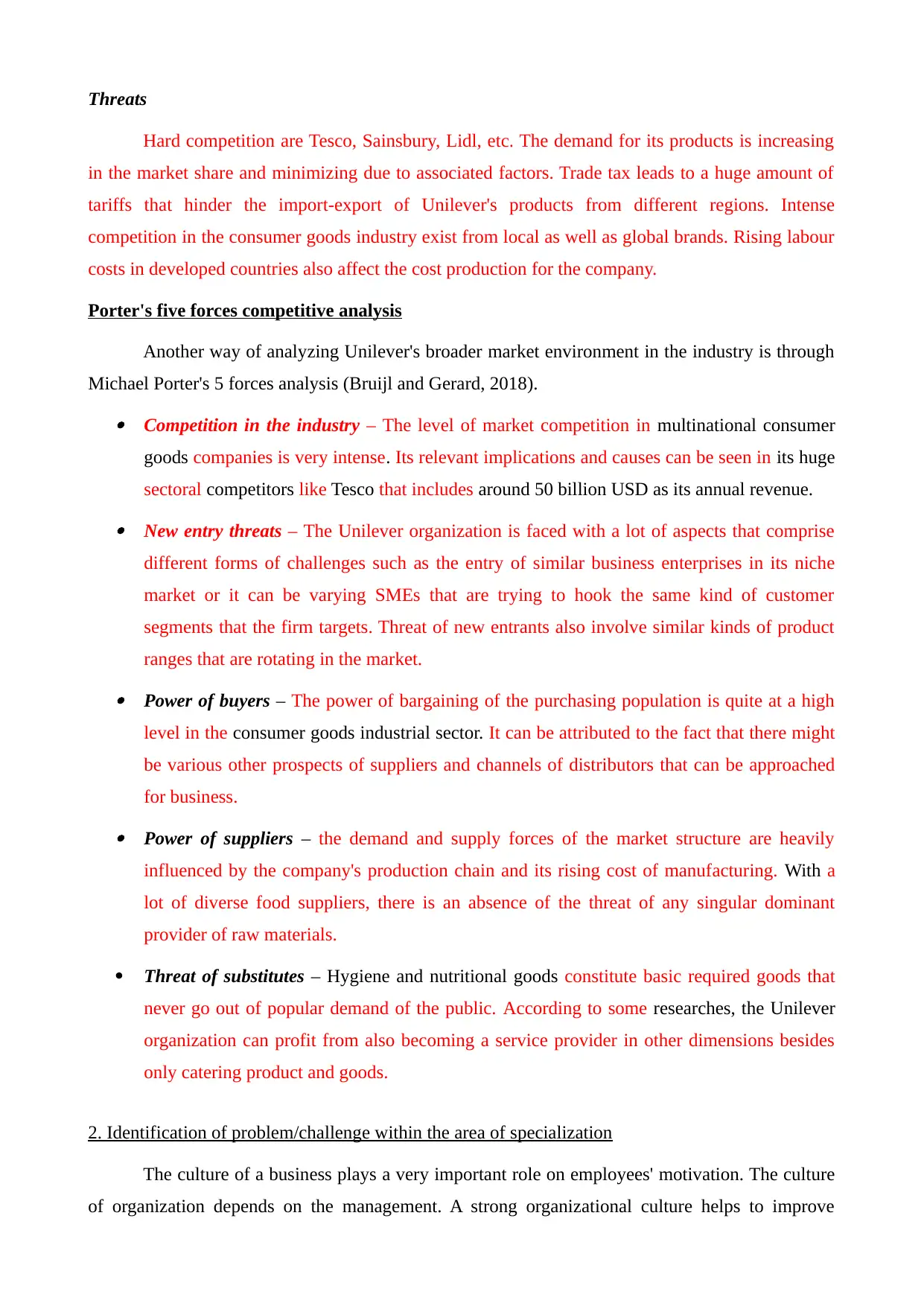
Threats
Hard competition are Tesco, Sainsbury, Lidl, etc. The demand for its products is increasing
in the market share and minimizing due to associated factors. Trade tax leads to a huge amount of
tariffs that hinder the import-export of Unilever's products from different regions. Intense
competition in the consumer goods industry exist from local as well as global brands. Rising labour
costs in developed countries also affect the cost production for the company.
Porter's five forces competitive analysis
Another way of analyzing Unilever's broader market environment in the industry is through
Michael Porter's 5 forces analysis (Bruijl and Gerard, 2018).
Competition in the industry – The level of market competition in multinational consumer
goods companies is very intense. Its relevant implications and causes can be seen in its huge
sectoral competitors like Tesco that includes around 50 billion USD as its annual revenue.
New entry threats – The Unilever organization is faced with a lot of aspects that comprise
different forms of challenges such as the entry of similar business enterprises in its niche
market or it can be varying SMEs that are trying to hook the same kind of customer
segments that the firm targets. Threat of new entrants also involve similar kinds of product
ranges that are rotating in the market.
Power of buyers – The power of bargaining of the purchasing population is quite at a high
level in the consumer goods industrial sector. It can be attributed to the fact that there might
be various other prospects of suppliers and channels of distributors that can be approached
for business.
Power of suppliers – the demand and supply forces of the market structure are heavily
influenced by the company's production chain and its rising cost of manufacturing. With a
lot of diverse food suppliers, there is an absence of the threat of any singular dominant
provider of raw materials.
Threat of substitutes – Hygiene and nutritional goods constitute basic required goods that
never go out of popular demand of the public. According to some researches, the Unilever
organization can profit from also becoming a service provider in other dimensions besides
only catering product and goods.
2. Identification of problem/challenge within the area of specialization
The culture of a business plays a very important role on employees' motivation. The culture
of organization depends on the management. A strong organizational culture helps to improve
Hard competition are Tesco, Sainsbury, Lidl, etc. The demand for its products is increasing
in the market share and minimizing due to associated factors. Trade tax leads to a huge amount of
tariffs that hinder the import-export of Unilever's products from different regions. Intense
competition in the consumer goods industry exist from local as well as global brands. Rising labour
costs in developed countries also affect the cost production for the company.
Porter's five forces competitive analysis
Another way of analyzing Unilever's broader market environment in the industry is through
Michael Porter's 5 forces analysis (Bruijl and Gerard, 2018).
Competition in the industry – The level of market competition in multinational consumer
goods companies is very intense. Its relevant implications and causes can be seen in its huge
sectoral competitors like Tesco that includes around 50 billion USD as its annual revenue.
New entry threats – The Unilever organization is faced with a lot of aspects that comprise
different forms of challenges such as the entry of similar business enterprises in its niche
market or it can be varying SMEs that are trying to hook the same kind of customer
segments that the firm targets. Threat of new entrants also involve similar kinds of product
ranges that are rotating in the market.
Power of buyers – The power of bargaining of the purchasing population is quite at a high
level in the consumer goods industrial sector. It can be attributed to the fact that there might
be various other prospects of suppliers and channels of distributors that can be approached
for business.
Power of suppliers – the demand and supply forces of the market structure are heavily
influenced by the company's production chain and its rising cost of manufacturing. With a
lot of diverse food suppliers, there is an absence of the threat of any singular dominant
provider of raw materials.
Threat of substitutes – Hygiene and nutritional goods constitute basic required goods that
never go out of popular demand of the public. According to some researches, the Unilever
organization can profit from also becoming a service provider in other dimensions besides
only catering product and goods.
2. Identification of problem/challenge within the area of specialization
The culture of a business plays a very important role on employees' motivation. The culture
of organization depends on the management. A strong organizational culture helps to improve
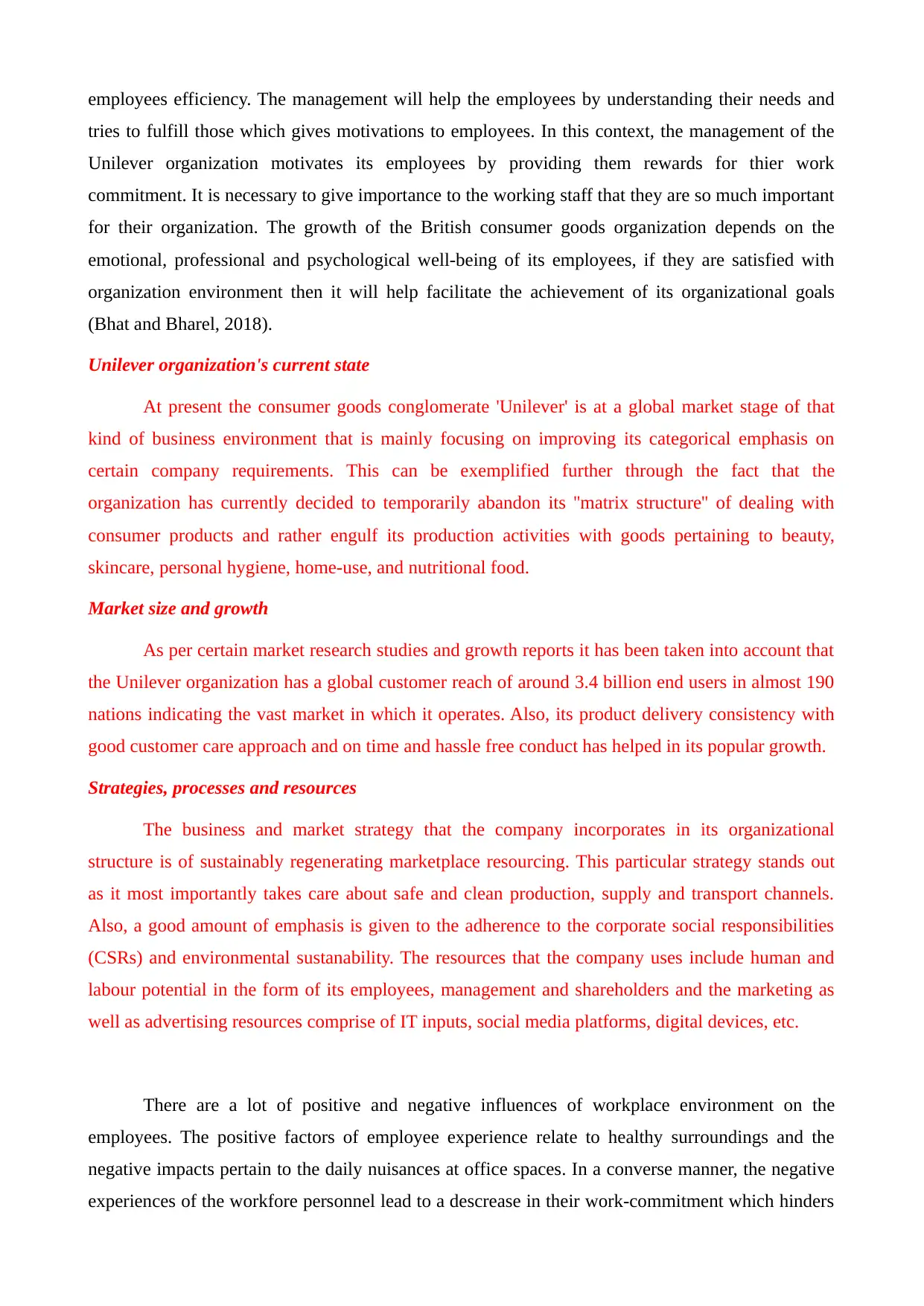
employees efficiency. The management will help the employees by understanding their needs and
tries to fulfill those which gives motivations to employees. In this context, the management of the
Unilever organization motivates its employees by providing them rewards for thier work
commitment. It is necessary to give importance to the working staff that they are so much important
for their organization. The growth of the British consumer goods organization depends on the
emotional, professional and psychological well-being of its employees, if they are satisfied with
organization environment then it will help facilitate the achievement of its organizational goals
(Bhat and Bharel, 2018).
Unilever organization's current state
At present the consumer goods conglomerate 'Unilever' is at a global market stage of that
kind of business environment that is mainly focusing on improving its categorical emphasis on
certain company requirements. This can be exemplified further through the fact that the
organization has currently decided to temporarily abandon its ''matrix structure'' of dealing with
consumer products and rather engulf its production activities with goods pertaining to beauty,
skincare, personal hygiene, home-use, and nutritional food.
Market size and growth
As per certain market research studies and growth reports it has been taken into account that
the Unilever organization has a global customer reach of around 3.4 billion end users in almost 190
nations indicating the vast market in which it operates. Also, its product delivery consistency with
good customer care approach and on time and hassle free conduct has helped in its popular growth.
Strategies, processes and resources
The business and market strategy that the company incorporates in its organizational
structure is of sustainably regenerating marketplace resourcing. This particular strategy stands out
as it most importantly takes care about safe and clean production, supply and transport channels.
Also, a good amount of emphasis is given to the adherence to the corporate social responsibilities
(CSRs) and environmental sustanability. The resources that the company uses include human and
labour potential in the form of its employees, management and shareholders and the marketing as
well as advertising resources comprise of IT inputs, social media platforms, digital devices, etc.
There are a lot of positive and negative influences of workplace environment on the
employees. The positive factors of employee experience relate to healthy surroundings and the
negative impacts pertain to the daily nuisances at office spaces. In a converse manner, the negative
experiences of the workfore personnel lead to a descrease in their work-commitment which hinders
tries to fulfill those which gives motivations to employees. In this context, the management of the
Unilever organization motivates its employees by providing them rewards for thier work
commitment. It is necessary to give importance to the working staff that they are so much important
for their organization. The growth of the British consumer goods organization depends on the
emotional, professional and psychological well-being of its employees, if they are satisfied with
organization environment then it will help facilitate the achievement of its organizational goals
(Bhat and Bharel, 2018).
Unilever organization's current state
At present the consumer goods conglomerate 'Unilever' is at a global market stage of that
kind of business environment that is mainly focusing on improving its categorical emphasis on
certain company requirements. This can be exemplified further through the fact that the
organization has currently decided to temporarily abandon its ''matrix structure'' of dealing with
consumer products and rather engulf its production activities with goods pertaining to beauty,
skincare, personal hygiene, home-use, and nutritional food.
Market size and growth
As per certain market research studies and growth reports it has been taken into account that
the Unilever organization has a global customer reach of around 3.4 billion end users in almost 190
nations indicating the vast market in which it operates. Also, its product delivery consistency with
good customer care approach and on time and hassle free conduct has helped in its popular growth.
Strategies, processes and resources
The business and market strategy that the company incorporates in its organizational
structure is of sustainably regenerating marketplace resourcing. This particular strategy stands out
as it most importantly takes care about safe and clean production, supply and transport channels.
Also, a good amount of emphasis is given to the adherence to the corporate social responsibilities
(CSRs) and environmental sustanability. The resources that the company uses include human and
labour potential in the form of its employees, management and shareholders and the marketing as
well as advertising resources comprise of IT inputs, social media platforms, digital devices, etc.
There are a lot of positive and negative influences of workplace environment on the
employees. The positive factors of employee experience relate to healthy surroundings and the
negative impacts pertain to the daily nuisances at office spaces. In a converse manner, the negative
experiences of the workfore personnel lead to a descrease in their work-commitment which hinders
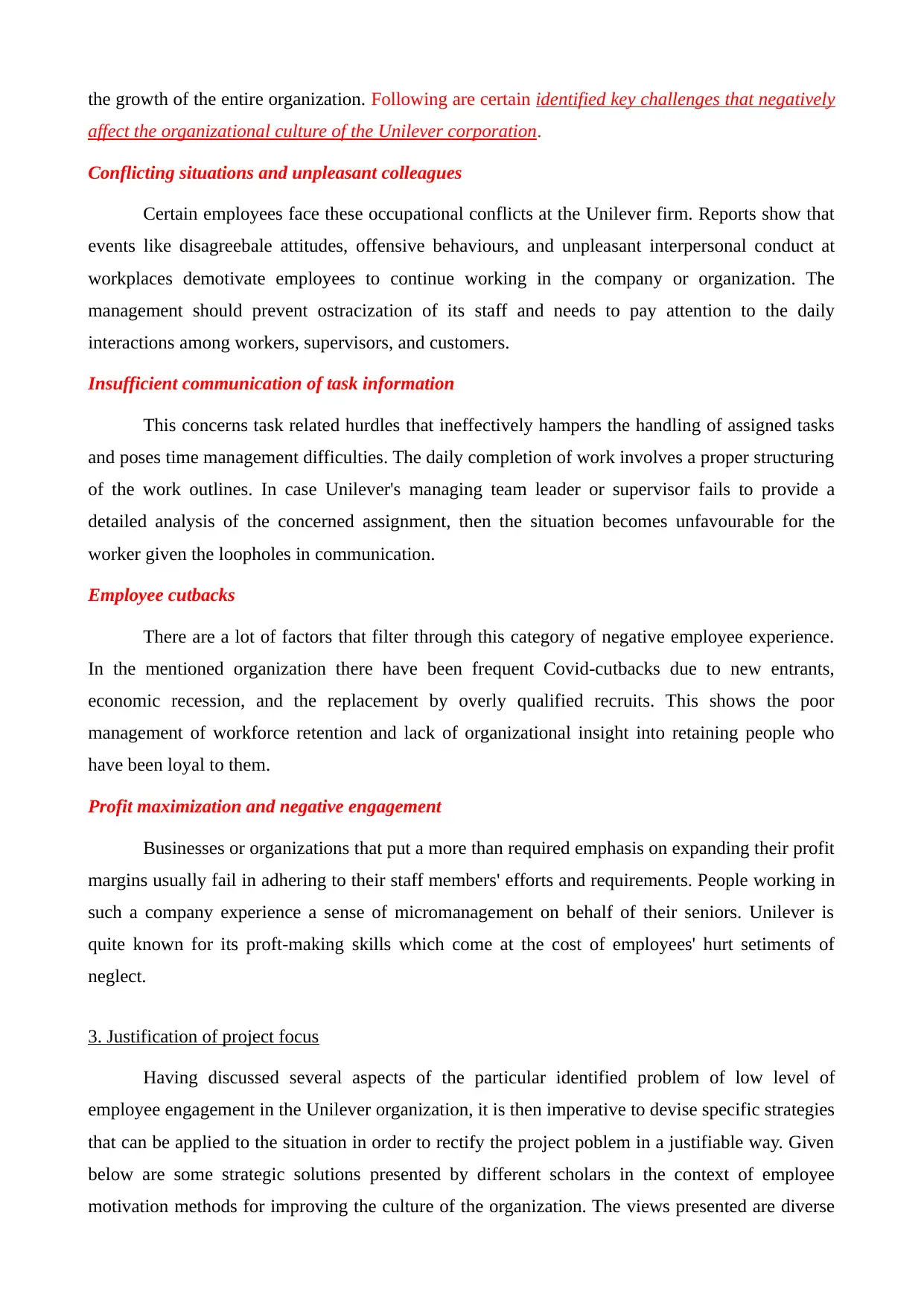
the growth of the entire organization. Following are certain identified key challenges that negatively
affect the organizational culture of the Unilever corporation.
Conflicting situations and unpleasant colleagues
Certain employees face these occupational conflicts at the Unilever firm. Reports show that
events like disagreebale attitudes, offensive behaviours, and unpleasant interpersonal conduct at
workplaces demotivate employees to continue working in the company or organization. The
management should prevent ostracization of its staff and needs to pay attention to the daily
interactions among workers, supervisors, and customers.
Insufficient communication of task information
This concerns task related hurdles that ineffectively hampers the handling of assigned tasks
and poses time management difficulties. The daily completion of work involves a proper structuring
of the work outlines. In case Unilever's managing team leader or supervisor fails to provide a
detailed analysis of the concerned assignment, then the situation becomes unfavourable for the
worker given the loopholes in communication.
Employee cutbacks
There are a lot of factors that filter through this category of negative employee experience.
In the mentioned organization there have been frequent Covid-cutbacks due to new entrants,
economic recession, and the replacement by overly qualified recruits. This shows the poor
management of workforce retention and lack of organizational insight into retaining people who
have been loyal to them.
Profit maximization and negative engagement
Businesses or organizations that put a more than required emphasis on expanding their profit
margins usually fail in adhering to their staff members' efforts and requirements. People working in
such a company experience a sense of micromanagement on behalf of their seniors. Unilever is
quite known for its proft-making skills which come at the cost of employees' hurt setiments of
neglect.
3. Justification of project focus
Having discussed several aspects of the particular identified problem of low level of
employee engagement in the Unilever organization, it is then imperative to devise specific strategies
that can be applied to the situation in order to rectify the project poblem in a justifiable way. Given
below are some strategic solutions presented by different scholars in the context of employee
motivation methods for improving the culture of the organization. The views presented are diverse
affect the organizational culture of the Unilever corporation.
Conflicting situations and unpleasant colleagues
Certain employees face these occupational conflicts at the Unilever firm. Reports show that
events like disagreebale attitudes, offensive behaviours, and unpleasant interpersonal conduct at
workplaces demotivate employees to continue working in the company or organization. The
management should prevent ostracization of its staff and needs to pay attention to the daily
interactions among workers, supervisors, and customers.
Insufficient communication of task information
This concerns task related hurdles that ineffectively hampers the handling of assigned tasks
and poses time management difficulties. The daily completion of work involves a proper structuring
of the work outlines. In case Unilever's managing team leader or supervisor fails to provide a
detailed analysis of the concerned assignment, then the situation becomes unfavourable for the
worker given the loopholes in communication.
Employee cutbacks
There are a lot of factors that filter through this category of negative employee experience.
In the mentioned organization there have been frequent Covid-cutbacks due to new entrants,
economic recession, and the replacement by overly qualified recruits. This shows the poor
management of workforce retention and lack of organizational insight into retaining people who
have been loyal to them.
Profit maximization and negative engagement
Businesses or organizations that put a more than required emphasis on expanding their profit
margins usually fail in adhering to their staff members' efforts and requirements. People working in
such a company experience a sense of micromanagement on behalf of their seniors. Unilever is
quite known for its proft-making skills which come at the cost of employees' hurt setiments of
neglect.
3. Justification of project focus
Having discussed several aspects of the particular identified problem of low level of
employee engagement in the Unilever organization, it is then imperative to devise specific strategies
that can be applied to the situation in order to rectify the project poblem in a justifiable way. Given
below are some strategic solutions presented by different scholars in the context of employee
motivation methods for improving the culture of the organization. The views presented are diverse
Paraphrase This Document
Need a fresh take? Get an instant paraphrase of this document with our AI Paraphraser
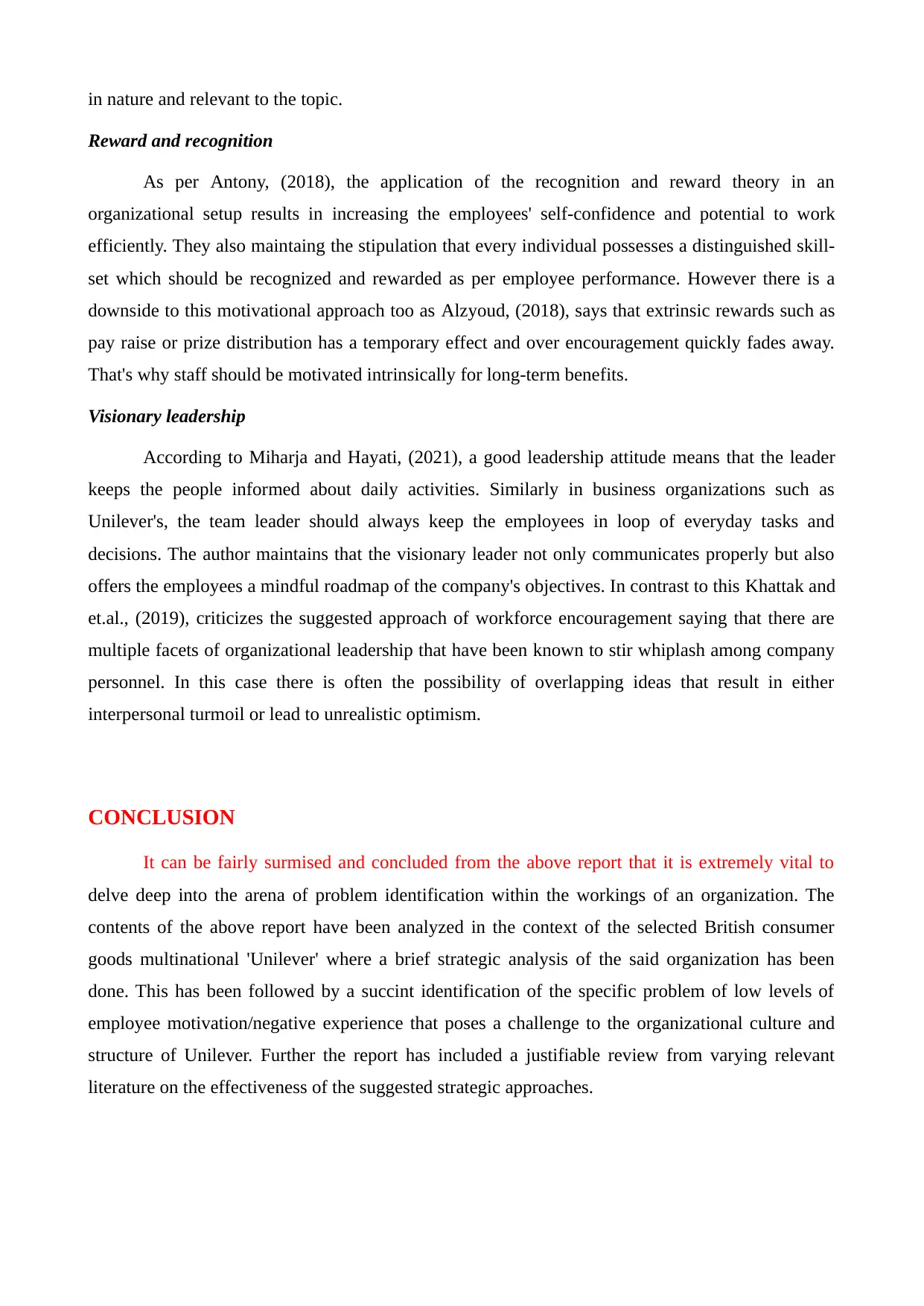
in nature and relevant to the topic.
Reward and recognition
As per Antony, (2018), the application of the recognition and reward theory in an
organizational setup results in increasing the employees' self-confidence and potential to work
efficiently. They also maintaing the stipulation that every individual possesses a distinguished skill-
set which should be recognized and rewarded as per employee performance. However there is a
downside to this motivational approach too as Alzyoud, (2018), says that extrinsic rewards such as
pay raise or prize distribution has a temporary effect and over encouragement quickly fades away.
That's why staff should be motivated intrinsically for long-term benefits.
Visionary leadership
According to Miharja and Hayati, (2021), a good leadership attitude means that the leader
keeps the people informed about daily activities. Similarly in business organizations such as
Unilever's, the team leader should always keep the employees in loop of everyday tasks and
decisions. The author maintains that the visionary leader not only communicates properly but also
offers the employees a mindful roadmap of the company's objectives. In contrast to this Khattak and
et.al., (2019), criticizes the suggested approach of workforce encouragement saying that there are
multiple facets of organizational leadership that have been known to stir whiplash among company
personnel. In this case there is often the possibility of overlapping ideas that result in either
interpersonal turmoil or lead to unrealistic optimism.
CONCLUSION
It can be fairly surmised and concluded from the above report that it is extremely vital to
delve deep into the arena of problem identification within the workings of an organization. The
contents of the above report have been analyzed in the context of the selected British consumer
goods multinational 'Unilever' where a brief strategic analysis of the said organization has been
done. This has been followed by a succint identification of the specific problem of low levels of
employee motivation/negative experience that poses a challenge to the organizational culture and
structure of Unilever. Further the report has included a justifiable review from varying relevant
literature on the effectiveness of the suggested strategic approaches.
Reward and recognition
As per Antony, (2018), the application of the recognition and reward theory in an
organizational setup results in increasing the employees' self-confidence and potential to work
efficiently. They also maintaing the stipulation that every individual possesses a distinguished skill-
set which should be recognized and rewarded as per employee performance. However there is a
downside to this motivational approach too as Alzyoud, (2018), says that extrinsic rewards such as
pay raise or prize distribution has a temporary effect and over encouragement quickly fades away.
That's why staff should be motivated intrinsically for long-term benefits.
Visionary leadership
According to Miharja and Hayati, (2021), a good leadership attitude means that the leader
keeps the people informed about daily activities. Similarly in business organizations such as
Unilever's, the team leader should always keep the employees in loop of everyday tasks and
decisions. The author maintains that the visionary leader not only communicates properly but also
offers the employees a mindful roadmap of the company's objectives. In contrast to this Khattak and
et.al., (2019), criticizes the suggested approach of workforce encouragement saying that there are
multiple facets of organizational leadership that have been known to stir whiplash among company
personnel. In this case there is often the possibility of overlapping ideas that result in either
interpersonal turmoil or lead to unrealistic optimism.
CONCLUSION
It can be fairly surmised and concluded from the above report that it is extremely vital to
delve deep into the arena of problem identification within the workings of an organization. The
contents of the above report have been analyzed in the context of the selected British consumer
goods multinational 'Unilever' where a brief strategic analysis of the said organization has been
done. This has been followed by a succint identification of the specific problem of low levels of
employee motivation/negative experience that poses a challenge to the organizational culture and
structure of Unilever. Further the report has included a justifiable review from varying relevant
literature on the effectiveness of the suggested strategic approaches.
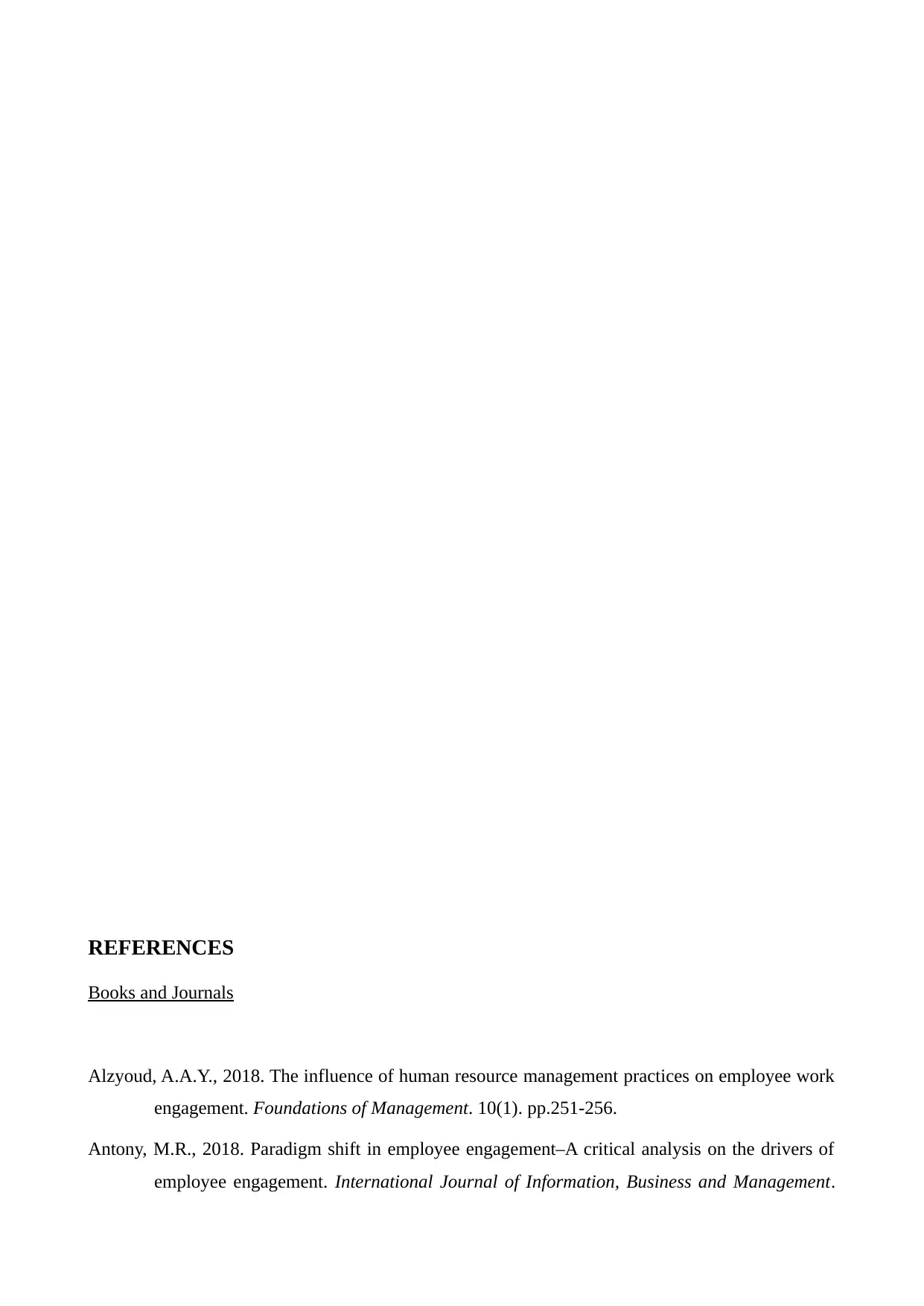
REFERENCES
Books and Journals
Alzyoud, A.A.Y., 2018. The influence of human resource management practices on employee work
engagement. Foundations of Management. 10(1). pp.251-256.
Antony, M.R., 2018. Paradigm shift in employee engagement–A critical analysis on the drivers of
employee engagement. International Journal of Information, Business and Management.
Books and Journals
Alzyoud, A.A.Y., 2018. The influence of human resource management practices on employee work
engagement. Foundations of Management. 10(1). pp.251-256.
Antony, M.R., 2018. Paradigm shift in employee engagement–A critical analysis on the drivers of
employee engagement. International Journal of Information, Business and Management.
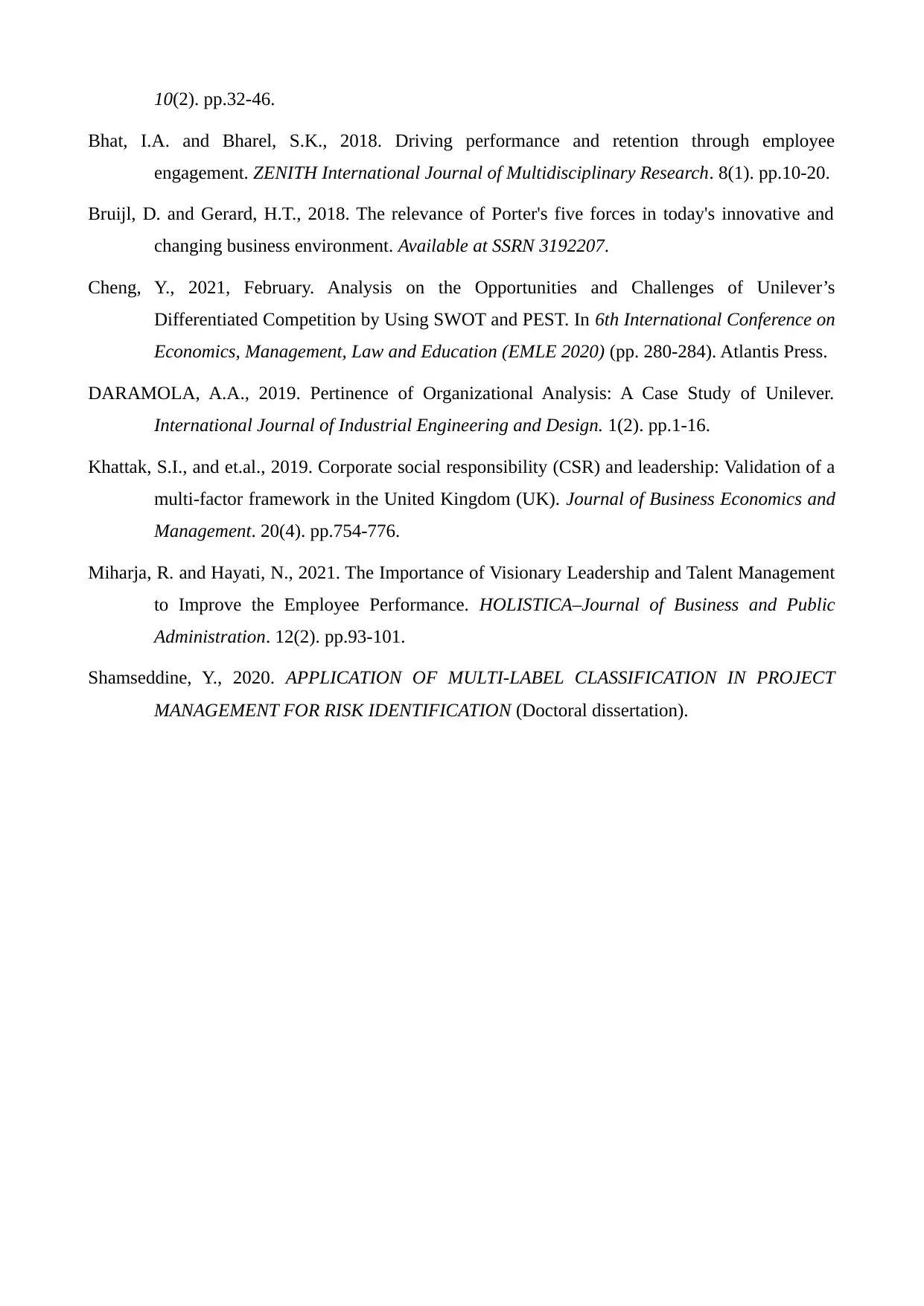
10(2). pp.32-46.
Bhat, I.A. and Bharel, S.K., 2018. Driving performance and retention through employee
engagement. ZENITH International Journal of Multidisciplinary Research. 8(1). pp.10-20.
Bruijl, D. and Gerard, H.T., 2018. The relevance of Porter's five forces in today's innovative and
changing business environment. Available at SSRN 3192207.
Cheng, Y., 2021, February. Analysis on the Opportunities and Challenges of Unilever’s
Differentiated Competition by Using SWOT and PEST. In 6th International Conference on
Economics, Management, Law and Education (EMLE 2020) (pp. 280-284). Atlantis Press.
DARAMOLA, A.A., 2019. Pertinence of Organizational Analysis: A Case Study of Unilever.
International Journal of Industrial Engineering and Design. 1(2). pp.1-16.
Khattak, S.I., and et.al., 2019. Corporate social responsibility (CSR) and leadership: Validation of a
multi-factor framework in the United Kingdom (UK). Journal of Business Economics and
Management. 20(4). pp.754-776.
Miharja, R. and Hayati, N., 2021. The Importance of Visionary Leadership and Talent Management
to Improve the Employee Performance. HOLISTICA–Journal of Business and Public
Administration. 12(2). pp.93-101.
Shamseddine, Y., 2020. APPLICATION OF MULTI-LABEL CLASSIFICATION IN PROJECT
MANAGEMENT FOR RISK IDENTIFICATION (Doctoral dissertation).
Bhat, I.A. and Bharel, S.K., 2018. Driving performance and retention through employee
engagement. ZENITH International Journal of Multidisciplinary Research. 8(1). pp.10-20.
Bruijl, D. and Gerard, H.T., 2018. The relevance of Porter's five forces in today's innovative and
changing business environment. Available at SSRN 3192207.
Cheng, Y., 2021, February. Analysis on the Opportunities and Challenges of Unilever’s
Differentiated Competition by Using SWOT and PEST. In 6th International Conference on
Economics, Management, Law and Education (EMLE 2020) (pp. 280-284). Atlantis Press.
DARAMOLA, A.A., 2019. Pertinence of Organizational Analysis: A Case Study of Unilever.
International Journal of Industrial Engineering and Design. 1(2). pp.1-16.
Khattak, S.I., and et.al., 2019. Corporate social responsibility (CSR) and leadership: Validation of a
multi-factor framework in the United Kingdom (UK). Journal of Business Economics and
Management. 20(4). pp.754-776.
Miharja, R. and Hayati, N., 2021. The Importance of Visionary Leadership and Talent Management
to Improve the Employee Performance. HOLISTICA–Journal of Business and Public
Administration. 12(2). pp.93-101.
Shamseddine, Y., 2020. APPLICATION OF MULTI-LABEL CLASSIFICATION IN PROJECT
MANAGEMENT FOR RISK IDENTIFICATION (Doctoral dissertation).
Secure Best Marks with AI Grader
Need help grading? Try our AI Grader for instant feedback on your assignments.
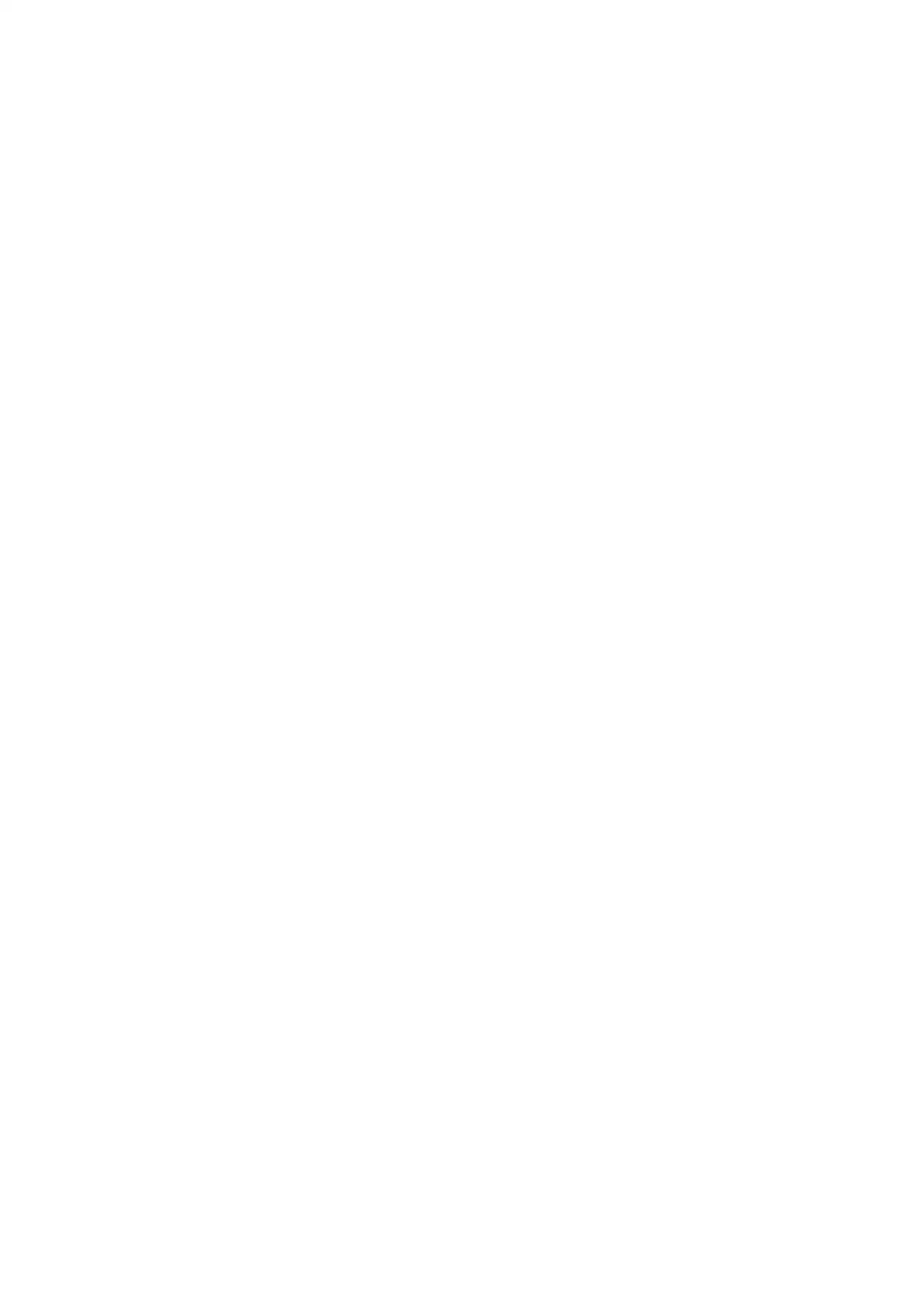
1 out of 11
Related Documents
Your All-in-One AI-Powered Toolkit for Academic Success.
+13062052269
info@desklib.com
Available 24*7 on WhatsApp / Email
![[object Object]](/_next/static/media/star-bottom.7253800d.svg)
Unlock your academic potential
© 2024 | Zucol Services PVT LTD | All rights reserved.




